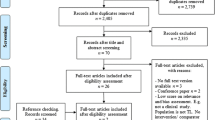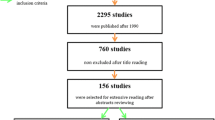Abstract
The objective of this study is to assess surgical parameters correlating with voice quality after total laryngectomy (TL) by relating voice and speech outcomes of TL speakers to surgical details. Seventy-six tracheoesophageal patients’ voice recordings of running speech and sustained vowel were assessed in terms of voice characteristics. Measurements were related to data retrieved from surgical reports and patient records. In standard TL (sTL), harmonics-to-noise ratio was more favorable after primary TL + postoperative RT than after salvage TL. Pause/breathing time increased when RT preceded TL, after extensive base of tongue resection, and after neck dissections. Fundamental frequency (f0) measures were better after neurectomy. Females showed higher minimum f0 and higher second formants. While voice quality differed widely after sTL, gastric pull-ups and non-circumferential pharyngeal reconstructions using (myo-)cutaneous flaps scored worst in voice and speech measures and the two tubed free flaps best. Formant/resonance measures in/a/indicated differences in pharyngeal lumen properties and cranio-caudal place of the neoglottic bar between pharyngeal reconstructions, and indicate that narrower pharynges and/or more superiorly located neoglottic bars bring with them favorable voice quality. Ranges in functional outcome after TL in the present data, and the effects of treatment and surgical variables such as radiotherapy, neurectomy, neck dissection, and differences between partial or circumferential reconstructions on different aspects of voice and speech underline the importance of these variables for voice quality. Using running speech, next to sustained/a/, renders more reliable results. More balanced data, and better detail in surgical reporting will improve our knowledge on voice quality after TL.



Similar content being viewed by others
References
Searl JP (2014) Reeves IS Chapter 9. Nonsurgical voice restoration following total laryngectomy. In: Ward EC, Van As-Brooks CJ (eds) Head and neck cancer: treatment, rehabilitation, and outcomes. 2nd edn. Plural Publishing, USA, pp 263–300
Oozeer NB, Owen S, Perez BZ, Jones G, Welch AR, Paleri V (2010) Functional status after total laryngectomy: cross-sectional survey of 79 laryngectomees using the Performance Status Scale for Head and Neck Cancer. J Laryngol Otol 124(4):412–416
Queija Ddos S, Portas JG, Dedivitis RA, Lehn CN, Barros AP (2009) Swallowing and quality of life after total laryngectomy and pharyngolaryngectomy. Braz J Otorhinolaryngol 75(4):556–564
Robertson SM, Yeo JC, Dunnet C, Young D, Mackenzie K (2012) Voice, swallowing, and quality of life after total laryngectomy: results of the west of Scotland laryngectomy audit. Head Neck 34(1):59–65
Ackerstaff AH, Hilgers FJ, Aaronson NK, Balm AJ (1994) Communication, functional disorders and lifestyle changes after total laryngectomy. Clin Otolaryngol Allied Sci 19(4):295–300
Kazi R, Kiverniti E, Prasad V, Venkitaraman R, Nutting CM, Clarke P et al (2006) Multidimensional assessment of female tracheoesophageal prosthetic speech. Clin Otolaryngol 31(6):511–517
Lundstrom E, Hammarberg B (2011) Speech and voice after laryngectomy: perceptual and acoustical analyses of tracheoesophageal speech related to voice handicap index. Folia Phoniatrica Logopaedica 63(2):98–108
Lundstrom E, Hammarberg B, Munck-Wikland E, Edsborg N (2008) The pharyngoesophageal segment in laryngectomees–videoradiographic, acoustic, and voice quality perceptual data. Logoped Phoniatr Vocol 33(3):115–125
D’Alatri L, Bussu F, Scarano E, Paludetti G, Marchese MR (2012) Objective and subjective assessment of tracheoesophageal prosthesis voice outcome. J Voice 26(5):607–613
van As-Brooks CJ, Koopmans-van Beinum FJ, Pols LC, Hilgers FJ (2006) Acoustic signal typing for evaluation of voice quality in tracheoesophageal speech. J Voice 20(3):355–368
Schuster M, Toy H, Lohscheller J, Eysholdt U, Rosanowski F (2005) Quality of life and voice handicap of laryngectomees using tracheoesophageal substitute voice. Laryngorhinootologie 84(2):101–107
Muller-Miny H, Diederich S, Bongartz G, Peters PE (1991) Radiologic findings following supraglottic and total laryngectomy. Der Radiol 31(7):324–331
Fitch WT, Giedd J (1999) Morphology and development of the human vocal tract: a study using magnetic resonance imaging. J Acous Soc Am 106(3 Pt 1):1511–1522
Reis N, Aguiar-Ricz L, Dantas RO, Ricz HM (2013) Correlation of intraluminal esophageal pressure with the dynamic extension of tracheoesophageal voice in total laryngectomees. Acta cirurgica brasileira/Sociedade Brasileira para Desenvolvimento Pesquisa em Cirurgia 28(5):391–396
Deschler DG, Doherty ET, Reed CG, Singer MI (1999) Effects of sound pressure levels on fundamental frequency in tracheoesophageal speakers. Otolaryngol Head Neck Surg 121(1):23–26
Takeshita-Monaretti TK, Dantas RO, Ricz H, Aguiar-Ricz LN (2014) Correlation of maximum phonation time and vocal intensity with intraluminal esophageal and pharyngoesophageal pressure in total laryngectomees. Ann Otol Rhinol Laryngol 123(11):811–816
Aguiar-Ricz L, Ricz H, de Mello-Filho FV, Perdona GC, Dantas RO (2010) Intraluminal esophageal pressures in speaking laryngectomees. Ann Otol Rhinol Laryngol 119(11):729–735
Iwai H, Tsuji H, Tachikawa T, Inoue T, Izumikawa M, Yamamichi K et al (2002) Neoglottic formation from posterior pharyngeal wall conserved in surgery for hypopharyngeal cancer. Auris Nasus Larynx 29(2):153–157
Brok HA, Stroeve RJ, Copper MP, Schouwenburg PF (1998) The treatment of hypertonicity of the pharyngo-oesophageal segment after laryngectomy. Clin Otolaryngol Allied Sci 23(4):302–307
Albirmawy OA, Elsheikh MN, Silver CE, Rinaldo A, Ferlito A (2012) Contemporary review: impact of primary neopharyngoplasty on acoustic characteristics of alaryngeal tracheoesophageal voice. Laryngoscope 122(2):299–306
McIvor J, Evans PF, Perry A, Cheesman AD (1990) Radiological assessment of post laryngectomy speech. Clin Radiol 41(5):312–316
Blom ED, Singer MI, Hamaker RC (1986) A prospective study of tracheoesophageal speech. Arch Otolaryngol Head Neck Surg 112(4):440–447
de Casso C, Slevin NJ, Homer JJ (2008) The impact of radiotherapy on swallowing and speech in patients who undergo total laryngectomy. Otolaryngol Head Neck Surg 139(6):792–797
Fouquet ML, Goncalves AJ, Behlau M (2009) Relation between videofluoroscopy of the esophagus and the quality of esophageal speech. Folia Phoniatrica Logopaedica 61(1):29–36
Gadepalli C, de Casso C, Silva S, Loughran S, Homer JJ (2012) Functional results of pharyngo-laryngectomy and total laryngectomy: a comparison. J Laryngol Otol 126(1):52–57
Kazi R, Singh A, Mullan GP, Venkitaraman R, Nutting CM, Clarke P et al (2006) Can objective parameters derived from video fluoroscopic assessment of post-laryngectomy valved speech replace current subjective measures? An e-tool-based analysis. Clin Otolaryngol 31(6):518–524
Maclean J, Szczesniak M, Cotton S, Cook I, Perry A (2011) Impact of a laryngectomy and surgical closure technique on swallow biomechanics and dysphagia severity. Otolaryngol Head Neck Surg 144(1):21–28
Singer MI, Blom ED, Hamaker RC (1986) Pharyngeal plexus neurectomy for alaryngeal speech rehabilitation. Laryngoscope. 96(1):50–54
Balm AJ, van den Brekel MW, Tan IB, Hilgers FJ (2011) The indwelling voice prosthesis for speech rehabilitation after total laryngectomy: a safe approach. Otolaryngologia polska/Polish Otolaryngol 65(6):402–409
Ng ML, Liu H, Zhao Q, Lam PK (2009) Long-term average spectral characteristics of Cantonese alaryngeal speech. Auris Nasus Larynx 36(5):571–577
Boersma P, Weenink D. Praat: doing phonetics by computer (Version 5.3.53) [Computer program]. http://www.praat.org. 5.3.53 ed2013
Traunmuller H, Eriksson A (1995) The perceptual evaluation of F0 excursions in speech as evidenced in liveliness estimations. J Acous Soc Am 97(3):1905–1915
Chone CT, Spina AL, Barcellos IH, Servin HH, Crespo AN (2011) A prospective study of long-term dysphagia following total laryngectomy. B-Ent 7(2):103–109
Maclean J, Cotton S, Perry A (2009) Dysphagia following a total laryngectomy: the effect on quality of life, functioning, and psychological well-being. Dysphagia 24(3):314–321
Landera MA, Lundy DS, Sullivan PA (2010) Dysphagia after total laryngectomy. Persp Swallow Swallow Disord (ASHA) 19:39–44
McConnel FM, Cerenko D, Mendelsohn MS (1988) Dysphagia after total laryngectomy. Otolaryngol Clin North Am 21(4):721–726
Op de Coul BM, van den Hoogen FJ, van As CJ, Marres HA, Joosten FB, Manni JJ et al (2003) Evaluation of the effects of primary myotomy in total laryngectomy on the neoglottis with the use of quantitative videofluoroscopy. Arch Otolaryngol Head Neck Surg 129(9):1000–1005
Blom ED, Pauloski BR, Hamaker RC (1995) Functional outcome after surgery for prevention of pharyngospasms in tracheoesophageal speakers. Part I: Speech characteristics. Laryngoscope 105(10):1093–1103
Chone CT, Seixas VO, Andreollo NA, Quagliato E, Barcelos IH, Spina AL et al (2009) Computerized manometry use to evaluate spasm in pharyngoesophageal segment in patients with poor tracheoesophageal speech before and after treatment with botulinum toxin. Braz J Otorhinolaryngol. 75(2):182–187
Deschler DG, Doherty ET, Reed CG, Hayden RE, Singer MI (2000) Prevention of pharyngoesophageal spasm after laryngectomy with a half-muscle closure technique. Ann Otol Rhinol Laryngol 109(5):514–518
Olson NR, Callaway E (1990) Nonclosure of pharyngeal muscle after laryngectomy. Ann Otol Rhinol Laryngol 99(7 Pt 1):507–508
van As CJ, Op de Coul BM, van den Hoogen FJ, Koopmans-van Beinum FJ, Hilgers FJ (2001) Quantitative videofluoroscopy: a new evaluation tool for tracheoesophageal voice production. Arch Otolaryngol Head Neck Surg 127(2):161–169
Op de Coul BM, Hilgers FJ, Balm AJ, Tan IB, van den Hoogen FJ, van Tinteren H (2000) A decade of postlaryngectomy vocal rehabilitation in 318 patients: a single Institution’s experience with consistent application of provox indwelling voice prostheses. Arch Otolaryngol Head Neck Surg 126(11):1320–1328
Evans S, Neave N, Wakelin D (2006) Relationships between vocal characteristics and body size and shape in human males: an evolutionary explanation for a deep male voice. Biol Psychol 72(2):160–163
Sisty NL, Weinberg B (1972) Formant frequency characteristics of esophageal speech. J Speech Hear Res 15(2):439–448
Schuster M, Rosanowski F, Schwarz R, Eysholdt U, Lohscheller J (2005) Quantitative detection of substitute voice generator during phonation in patients undergoing laryngectomy. Arch Otolaryngol Head Neck Surg 131(11):945952
Moon JB, Weinberg B (1987) Aerodynamic and myoelastic contributions to tracheoesophageal voice production. J Speech Hear Res 30(3):387–395
Hilgers FJ, Dirven R, Jacobi I, van den Brekel M (2015) Physiology and prospects of bimanual tracheoesophageal brass instrument play. Acta Otorhinolaryngol Italica 35(3):202–207
Acknowledgments
The Netherlands Cancer Institute receives a research grant from Atos Medical Sweden, which contributes to the existing infrastructure for health-related quality of life research of the department of Head and Neck Oncology and Surgery.
Author information
Authors and Affiliations
Corresponding author
Ethics declarations
Conflict of interest
The Netherlands Cancer Institute receives a research grant from Atos Medical Sweden, which contributes to the existing infrastructure for health-related quality of life research of the department of Head and Neck Oncology and Surgery.
Additional information
I. Jacobi and A. J. Timmermans contributed equally.
Rights and permissions
About this article
Cite this article
Jacobi, I., Timmermans, A.J., Hilgers, F.J.M. et al. Voice quality and surgical detail in post-laryngectomy tracheoesophageal speakers. Eur Arch Otorhinolaryngol 273, 2669–2679 (2016). https://doi.org/10.1007/s00405-015-3777-4
Received:
Accepted:
Published:
Issue Date:
DOI: https://doi.org/10.1007/s00405-015-3777-4




